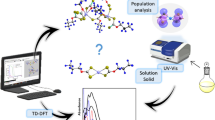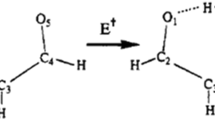Abstract
The rationalization of the properties of iron-phenantroline complexes has lead to their description in terms of Molecular System Organizations. In tris(phenantroline)iron complexes the coordination centre and its immediate environment, i.e. the FeN6 group is highly symmetrical and found nearly invariant towards changes in oxidation number, in substitution and in molecular environment. Its decisive regulating functions suggest its operation as the highest hierarchic level of the system. Subordinated to this hierarchic level appear the peripheric charge density regions of the complex ion, which are responsible for flexible adaptation of the system to its environment. The actions of this level are supported by the high flexibility of the π-electron system of the ligands and by the structural framework, both of which are considered to provide the lowest level.
As long as the highest level can provide for the invariance of the symmetrical framework of the FeN6 group, the complex is maintained in a low spin state. Distortion of the symmetry of the FeN6 group, as for example effectuated by a substituent in 2-position leads to an increase in dynamic properties and to the establishment of the high spin state, which is found also in bis(phenantroline)iron complexes (with less symmetrically arranged central regions). It is emphasized that anLS →HS transition involves passage of a state of high dynamic order. It is suggested to useArrhenius plots of the rate coefficients of homologous reactions as a measure of the system organization, which appears to be improved as thek-values are approaching those evaluated for the isokinetic temperature. It is finally emphasized that it is principally impossible to acquire full and precise knowledge of the molecular organization of a real system. The limited knowledge accessible may, however, lead to new aspects both in materials science and in biochemical aspects of biological systems.
Similar content being viewed by others
Literatur
Chew C. F., Science161, 762 (1968); Physics Today23, 23 (1970).
Bohm D., Wholeness and Implicate Order. London: Routledge and Kegan Paul. 1980.
Primas H., Chimia36, 293 (1982).
Einstein A., Podolsky B., Rosen N., Phys. Rev.47, 777 (1935); siehe auchBell J. S., Physics1, 195 (1964); sowieFreedman S., Clausen J., Phys. Rev. Letters28, 938 (1972).
Weiss P. A., Within the Gates of Science and Beyond. New York: Futura Publishing Company. 1971.
Schild A. A., Analytical Application of Phenantroline and Related Compounds. London-New York: Pergamon Press. 1969.
Vlček A. A., Chem. Revs.43, 39 (1983); Rev. Chim. Min.20, 612 (1983).
Koepp H. M., Wendt H., Strehlow H., Z. Elektrochem.64, 483 (1960);Nelson I. V., Iwamoto R. T., Anal. Chem.35, 867 (1963).
Gritzner G., Kuta J., Pure Applied Chem.56, 461 (1984).
Mayer U., Kotocova A., Gutmann V., J. Electroanal. Chem.103, 409 (1979).
Baker F.,Engelhardt L. M.,Figgs B. N.,White A. H., J. Chem. Soc. Dalton1975, 530.
Ussanovich M., Zhur. obshch. Khim.9, 182 (1939).
Gutmann V., Chemische Funktionslehre. Wien-New York: Springer. 1971.
Schmid R., Han L., Inorg. Chim. Acta69, 127 (1983).
Bond-Smith M. H., Sutin L., J. Amer. Chem. Soc.83, 1831 (1981).
Ugara K., Miyamoto K., Electrochim. Acta22, 1357 (1977).
Epstein M. L., J. chem. Phys.40, 435 (1964).
Greenwood N. N., Gibbs T. C., Mössbauer Spectroscopy. London: Chapman and Hall. 1971.
Gray V. K., Malathi Puri S. P., Chem. Phys. Letters11, 393 (1979).
Levison K. A., Perkins P. G., Theor. Chim. Acta14, 206 (1969).
Linert W.,Gutmann V.,Wiesinger G.,Perkins P. G., Z. physik. Chem. (Leipzig), im Druck.
Schmid R., Soukup R. W., Arasteh M. K., Gutmann V., Inorg. Chim. Acta73, 21 (1983).
Gutmann V., The Donor-Acceptor Approach to Molecular Interactions. New York: Plenum Press. 1978.
Elsaesser M. V., The Chief Abstractions of Biology. Amsterdam: North-Holland. 1975.
Gutmann V., Resch G., Kratz R., Schauer H., Monatsh. Chem.115, 551 (1984).
Resch G., Gutmann V., Z. physik. Chem. (n. F.)121, 211 (1980).
Resch G., Gutmann V., Z. physik. Chem. (n. F.)126, 223 (1981).
Gutmann V., Resch G., Inorg. Chim. Acta72, 269 (1983).
Gutmann V., Resch G., Monatsh. Chem.114, 839 (1983).
Gutmann V., Resch G., Pure Applied Chem.53, 1447 (1981).
Gutmann V., Resch G., Comments Inorg. Chem.1, 265 (1982).
Primas H., Chemistry Quantum Mechanics and Reductionism. Berlin-Heidelberg-New York: Springer. 1983.
Saji T., Fukai T., Aoyagui S., J. Electroanal. Chem.66, 81 (1975).
Schmid R., Sapunov V., Non Formal Kinetics in Search for Chemical Reaction Pathways. Weinheim-New York: Verlag Chemie. 1982.Exner O., Phys. Org. Chem.10, 411 (1973).
Fleisch J., Gütlich P., Hasselbach K. M., Inorg. Chem.16, 1979 (1977).
König E., Ritter G., Goodwin H. A., J. Inorg. Nucl. Chem.39, 1773 (1977).
Goodwin H. A., Sylva R. N., Austral. J. Chem.21, 83 (1968).
Fleisch J., Gütlich P., Hasselbach K. M., Müller W., Inorg. Chem.15, 598 (1976).
Reiff W. M., Long C. J., Inorg. Chem.13, 2150 (1974).
Fleisch J., Gütlich P., Hasselbach K. M., Müller W., J. Physique 35 (12) C 6–659 (1974).
Fleisch J., Gütlich P., Hasselbach K. M., Inorg. Chim. Acta17, 51 (1976).
Gütlich P., Structure and Bonding44, 83 (1981).
König E., Watson K. J., Chem. Phys. Letters6, 457 (1970).
Author information
Authors and Affiliations
Rights and permissions
About this article
Cite this article
Gutmann, V., Resch, G. Fragen der molekularen Systemorganisation — I Eisen-Phenantrolin-Komplexe. Monatsh Chem 116, 1107–1123 (1985). https://doi.org/10.1007/BF00811244
Received:
Accepted:
Issue Date:
DOI: https://doi.org/10.1007/BF00811244




